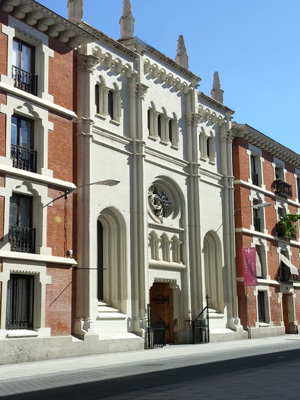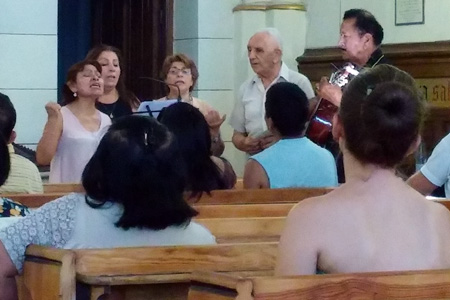| |
 |
 |
 |
| Comment on this report, or find other reports. |
 |
| Our Mystery Worshippers are volunteers who warm church pews for us around the world. If you'd like to become a Mystery Worshipper, start here. |
 |
| Find out how to reproduce this report in your church magazine or website. |
|
|
| 2893: Catedral del Redentor (Cathedral of the Redeemer), Madrid, Spain |
 |
 |
 |
Mystery Worshipper: Quixotic Don.
The church: Catedral del Redentor (Cathedral of the Redeemer), Madrid, Spain.
Denomination: Iglesia Española Reformada Episcopal (Spanish Reformed Episcopal Church). Organized in 1880 by former Roman Catholic priests and Reformed ministers, the Spanish Reformed Episcopal Church is an extra-provincial diocese in the Anglican Communion under the authority of the Archbishop of Canterbury.
The building: A narrow white stone structure sandwiched in between two red brick residential buildings. It is the work of late 19th-early 20th century Spanish architect Enrique María Repullés, who also designed the Madrid Stock Exchange and several churches in Madrid and in the provinces. The interior is downright stark compared to the riot of artwork one finds in most Spanish churches. A simple wooden altar sits in the apse, over which is a cross flanked by two narrow windows. The bishop’s throne is behind the altar. An old tracker organ stands off to the right of the nave.
The church: They sponsor youth and women’s groups, a Sunday school, and an assistance program for immigrants. Vespers is held on Saturday evenings, and matins and holy communion on Sunday mornings. There is also vespers on Wednesday evenings for senior citizens. The women’s group meets on Thursdays, and there is Bible study on Thursdays and Saturdays.
The neighbourhood: They are located on the Calle de la Beneficencia very near to the Alonso Martínez stop (lines 4, 5 and 10) or the Tribunal stop (lines 1 and 10) on the Metro. The cathedral is easier to find from the Tribunal stop; from the Alonso Martínez stop you need a good map and a good sense of direction. Protestantism never took hold in Spain to the extent it did elsewhere in Europe, due largely to the work of the Spanish Inquisition and heavy-handed repression during the Franco years. But I spotted some Mormon missionaries and Jehovah’s Witnesses along the Calle de Fuencarral, the delightful shopping street that runs south of the Tribunal Metro station and around the corner from the Calle de la Beneficiencia.
The cast: No names were given. There were four people in the altar party: two men in albs and black scarves who I assume were priests; one deacon in cassock and cotta and a green deacon’s stole; and one woman in an alb.
The date & time: Saturday, 25 July 2015, 6.00pm.
What was the name of the service?
Oficio Vespertino (Vespers).
How full was the building?
There were about 40 people – about one-third full.
Did anyone welcome you personally?
No. Several people stared at me as they walked past but no one said anything or acknowledged my presence in any other way.
Was your pew comfortable?
No. They were attractively carved wooden pews – pine, I think – but they were narrow and severe.
How would you describe the pre-service
atmosphere?
People were sitting fairly quietly, with some visiting. However, two women at the back of the church were cackling incessantly in loud voices – very annoying. As service time approached, the visiting got louder but ceased abruptly when the lights came up.
What were the exact opening words of the
service?
"En el nombre del nuestro Señor Jesucristo sea luz y paz" (Light and peace in the name of our Lord Jesus Christ).
What books did the congregation use during the
service?
An old man in a grey sleeveless t-shirt and shorts, who I assumed was the sexton, passed out a laminated card entitled Oficio Vespertino Breve (Short Order for Vespers). Words to the songs were projected onto the wall (not a screen) via transparencies on an overhead projector. No PowerPoint for us, please, we're Reformed Episcopal. They were hard to read on the wall – someone needs to donate a screen – and the person handling them kept jiggling them around and getting the order wrong. He was making me dizzy! Not that I could have sung along anyway – no music was given and the tunes were unfamiliar.
What musical instruments were played?
Acoustic guitar. There were three female vocalists and an old man who sang in raw, untrained voices (but with great emotion). The music was what I like to call "Singing Nun Goes South of the Border" back home – Spanish, folksy.
Did anything distract you?
It was very hot inside. Air conditioning is something the Spanish seem to roll out to tourists for their benefit, if at all. Many people fanned themselves with hand fans, including the woman member of the altar party – whose fan, I’m pleased to say, was liturgically correct green.

Was the worship stiff-upper-lip, happy clappy, or
what?
Definitely happy-clappy. Everybody was getting jiggy with it, including the altar party. The order of service was unlike any vespers I’m used to – basically a hymn sandwich, with verses and responses, prayers, songs, sermon, offering and announcements. No Phos hilaron, no Magnificat, no Nunc dimittis, no incense. It pretty much followed the laminated card we were given – at least in the beginning and the end, although I really don’t know what was going on in the middle. But the people were right on top with their responses to whatever it was. The Lord’s Prayer was read by the woman in the altar party, and the people replied "Amen" after each sentence. As the offering was being received, the vocalists sang a Sanctus with so much enthusiasm I thought they were going to break out in Flamenco!
Exactly how long was the sermon?
13 minutes.
On a scale of 1-10, how good was the preacher?
7 – It was clear that the preacher, one of the priests in the altar party, did not have Spanish as his native language. I believe I heard him say he was Canadian. He read his sermon from a prepared text (for which I forgive him – I can’t speak Spanish extemporaneously either). I believe I understood most of what he said, and his sermon seemed well prepared.
In a nutshell, what was the sermon
about?
"The last shall be first, and the first last." We hear those words over and over again, but what do they really mean? Will money or fame get us to heaven? Material things are not important. Jesus has a prize waiting for us that is beyond our imagination. Be optimistic. Be enthusiastic about what lies ahead.
Which part of the service was like being in
heaven?
I was pleased to be able to understand the sermon. I generally can’t understand native speakers of Spanish who talk at conversational speed, but I’m not too bad with American-accented speakers. And one of the vocalists sang with special ecstatic fervor.

And which part was like being in... er... the other place?
Lord, it was hot in there! At the end of the service, the deacon gave announcements and said some other things – I didn’t understand him – that seemed to go on and on. The only effect it seemed to have was that it made the people fan themselves all the more vigorously.
What happened when you hung around after the service looking lost?
The service ended with a song, the refrain of which went "Dame la mano, y mi hermano seres" (Give me your hand, and you will be my brother), to the tune of what sounded like the American cowboy folk song Red River Valley (yes, I swear it did!). This gave rise to a general exchange of peace – hugging, kissing, shaking of hands – but no one made it back as far as my pew, although I was not sitting in the last row. So much for taking one's brother by the hand.
How would you describe the after-service
coffee?
The altar party departed, the lights were dimmed, the musicians left, but everybody remained in their pews. Something was about to happen – somehow I didn’t think it would be Benediction of the Blessed Sacrament, though. It certainly wasn’t coffee. I shrugged my shoulders and tried to make eye contact with various people, but again no one acknowledged me or said anything to me. I had hoped to be able to talk with the Canadian priest, and waited around a bit thinking he'd come back out. But he didn't, so I left.
How would you feel about making this church your regular (where 10 = ecstatic, 0 = terminal)?
4 – Everyone seemed to be having a jolly old time, but what is it with these Spanish congregations who are so aloof to strangers in their midst? During my time in Spain I’ve come to expect it from Catholic congregations, but I was hoping things would be different in an Anglican church. I had taken the trouble to seek them out – they're not mentioned in the guide books, and they're not marked by a black cross on any of the tourist maps, as are other churches. At the very least, a Buenas tardes, bienvenido from someone would have been nice. I really don’t know what would happen if I lived here permanently and tried to make this church my regular. I'd want more from their music program than the Andrews Sisters and Rudy Vallee, though.
Did the service make you feel glad to be a
Christian?
I guess so.
What one thing will you remember about all this in seven days' time?
Red River Valley. |
|
|
 |
 |
 |
| We rely on voluntary donations to stay online. If you're a regular visitor to Ship of Fools, please consider supporting us. |
 |
 |
 |
| The Mystery Pilgrim |
 |
| One of our most seasoned reporters makes the Camino pilgrimage to Santiago de Compostela in Spain. Read here. |
 |
 |
 |
| London churches |
 |
| Read reports from 70 London churches, visited by a small army of Mystery Worshippers on one single Sunday. Read here. |
| |
|
|
|
|


